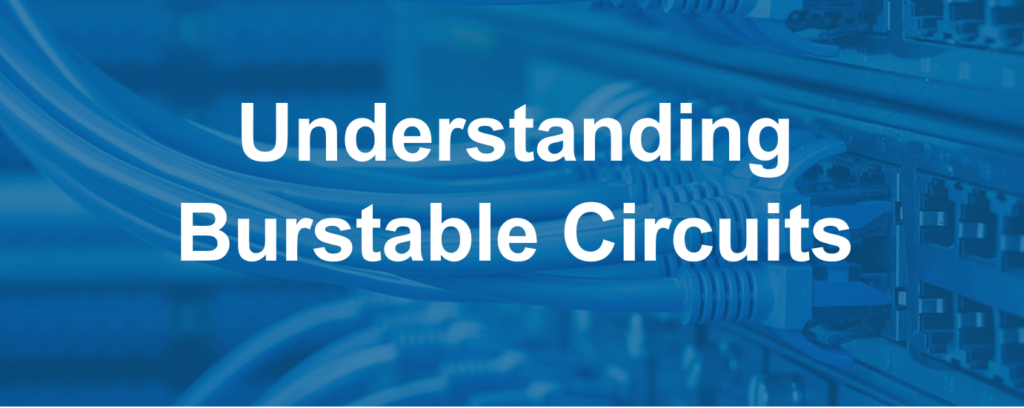
All companies rely on various data circuits for their business. Internet circuits are by far the most prevalent. In this article we’ll explore the two main ways that Internet circuits are contracted and billed, and discuss the situations that favor each approach.
The most common way of contracting Internet circuits is known as fixed bandwidth. In this model, you might have a 10Gbps circuit, where you pay a fixed monthly cost, and have the full use of the contracted bandwidth at the fixed cost. With such a contracted circuit, it doesn’t matter if you run the circuit at 10Gbps every minute of every day, or use no bandwidth at all–you’ll have a fixed monthly cost for the duration of the contract, and no surprises.
Another approach is known as a burstable circuit. Burstable circuits can be good for demand patterns where the full circuit capacity is only needed for brief periods of time, and where most of the time the circuit only has to carry a smaller amount of data. Following are the main points to understand about how a burstable circuit works:
Burst Capacity: The peak amount of bandwidth the circuit can handle. In this example we’ll stick with a 10Gbps burst capacity.
Committed Data Rate (CDR): The amount of committed bandwidth that will be billed every month. Usually this ranges from 10% to 20% of the Burst Capacity. For this example we’ll assume a 2Gbps CDR (20% of Burst Capacity).
CDR Unit Rate: The cost for the units of CDR that are committed. Typically this is stated per Mbps. For this example, we’ll use $0.35 per Mbps as the CDR unit rate, so for this 2Gbps CDR the monthly minimum cost that would be billed would be $700.
Burst Unit Rate: The cost for the units consumed over the CDR. This is also usually stated per Mbps. Often this unit rate can be set higher than for the CDR unit rate, although it’s not unusual for AIQ to obtain Burst Unit Rates that are the same as, if not lower than, the CDR Unit Rate. For this example, we’ll use a Burst Unit Rate of $0.40 per Mbps.
Burst Calculation Method: An important question is how the supplier will calculate how much burst capacity is used in a given month. By far the most common method is the 95th Percentile approach. In this method, the usage of the circuit is measured in regular fixed intervals. At the end of the month, the usage measurements are sorted from highest to lowest, and then the top 5% of the measurements are thrown away, such that the next smaller measurement is the burst usage. Some suppliers offer 90th Percentile burst calculation, which can be a considerable benefit depending on the circuit’s usage pattern over time.

Fig. 1: Example Sorted Usage
Figure 1 shows a hypothetical 10Gbps circuit usage over a month, with the usage measurements sorted from lowest to highest. In this example, the 95th Percentile usage is 4,165Mbps, although the circuit did see some periods of use at nearly the maximum burst capacity. To calculate the monthly charge for this circuit:
- CDR: 2,000 Mbps
- CDR Rate: $0.35/Mbps
- CDR Charge: $700
- Burst Usage (95th Percentile – CDR): 2,165 Mbps
- Burst Rate: $0.40/Mbps
- Burst Charge: $866
- Total Monthly Cost (CDR + Burst): $1,566
In the example shown, the 90th Percentile charge is even less:
- Burst Usage (90th Percentile – CDR): 1,277 Mbps
- Burst Rate: $0.40/Mbps
- Burst Charge: $511
- Total Monthly Cost (CDR + Burst): $1,211
At this point, you can see the potential value of a burstable circuit in situations where brief peak capacity bandwidth is needed, but where most of the time the circuit sees considerably less use. However, what you don’t know is whether a burstable circuit would actually cost your company less than a full fixed-capacity 10Gbps circuit. And perhaps your company may use hundreds of circuits like this example, making this a daunting task for any Operations or IT group to achieve the best cost.
Fortunately, AIQ can help: we apply our deep expertise and potent market forces on your behalf to obtain the best cost available from the market for all of your circuits, analyze the results, and deliver market-limit pricing from qualified suppliers that you approve.
